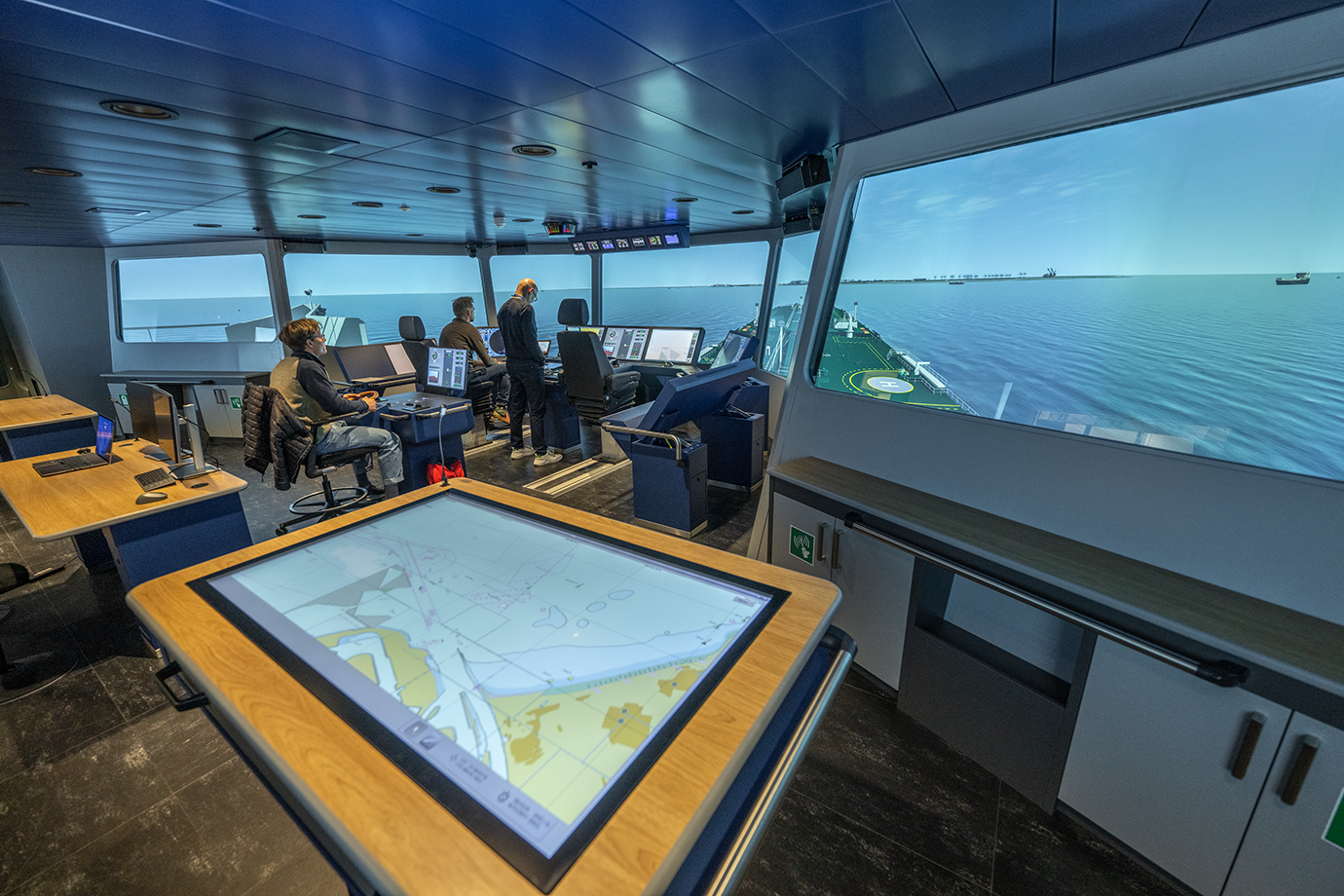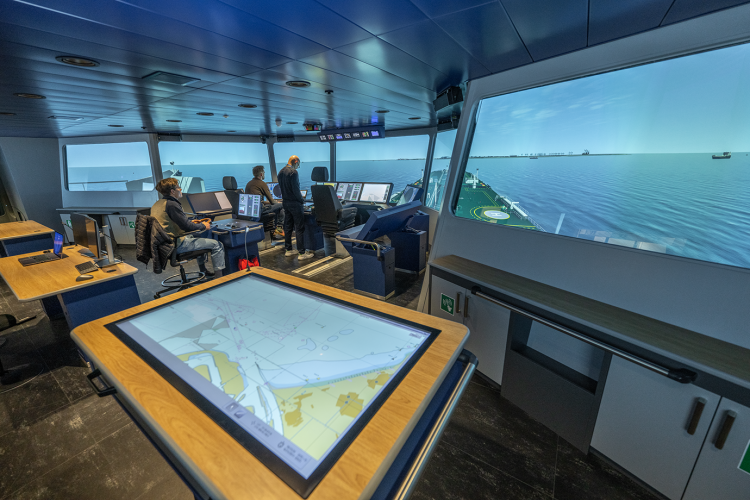June 2024, no. 140

Leaflet SOSc (pdf)
Drone tour of the SOSc.









More info
Create a MARIN account to stay updated

Report
A short tour of the Seven Oceans Simulator centre

Bridge simulators have always played an important role in MARIN’s portfolio –
a crucial link between the operational concept and the actual operation on board. This link is even stronger now with the Seven Oceans Simulator centre (SOSc). State-of-the-art simulators offer unprecedented possibilities to simulate all aspects of operations at sea and to give the human operator a central stage.
The ‘working horses’ of the SOSc are the two large ship simulators, the Large Motion Simulator (LMS) and the Full Mission Bridge (FMB). And certainly, the Large Motion Simulator is on an impressive scale. This is truly a one-of-a-kind facility, consisting of a ship’s bridge fitted on a motion base assembly. Uniquely, the bridge is surrounded by a spherical screen on which the outside world is projected. This gives a very large vertical field of view which makes it possible to see the quay directly next to the ship when mooring. All ship operations in which motions play a significant part can be simulated more realistically. Think of steering in high waves, operating wind assisted vessels, parametric rolling or research into capsizing events.
Dimitri van Heel,
Senior Project Manager Maritime Operations

Large-scale crisis response exercises
One of the new features in the SOSc is a Traffic & Mission Control room. The T&MC will function as a laboratory to test new Vessel Traffic Services (VTS) concepts and innovative solutions for remote/unmanned control operations. It can be coupled to the other simulators, and as such it provides the capability for large-scale crisis response exercises, in which manned simulated vessels can cooperate in coordinated rescue operations.
Another novelty is the Maritime Experience Lab. With its large open floor plan, the MX Lab offers possibilities to combine Virtual Reality applications with motion platforms. With this mix, we are able to include other parts of the operations on board of vessels, as well as the navigation bridge. For example, the sailors working on the deck of an offshore supply vessel can now be included. The Fast Small Ship Simulator and a cable robot are some of the features of the MX Lab.
Human Factor takes central stage
The human operator is always the centre of focus. For this reason, a specially developed toolkit with wearable sensors has been developed that allows the researcher to observe specific human factor measurements (eye trackers, heart rate, galvanic skin response etc.) and log this data together with all technical data coming from the simulators. This will enable us to ‘catch’ the human factor even better.
MARIN’s pioneering SOSc has indeed everything required to make maritime operations safer and more efficient, and provides the most realistic simulations of the behaviour and interactions of maritime constructions, the environment and the human operator in the world today.
Two bridge wings perfect for complex manoeuvring simulations
At 16 m wide, and equipped with two bridge wing positions, the Full Mission Bridge is enormous. It provides sufficient room for a large bridge team, with multiple flexible workspaces. Flexibility is the key word here. Not only can the controls be easily changed, also the setup of the consoles can be rearranged, ranging from a typical T-console and a one-man bridge, to a twin battery of consoles typically found on cruise vessels. A lot of attention has been paid to details, creating the look and feel of a large modern ship. The bridge wings have their own spherical projection domes and together with the main projection, they provide 240° coverage. From the bridge wings there are excellent views along the ship, perfect for manoeuvring close to the berth or side-by-side operations. In essence, this simulator is ideal for manoeuvring simulations with a large variety of ship types.
For the simulation of smaller ships, four multipurpose simulators are available. These versatile simulators can be used for tugs, inland vessels and supply ships etc. They consist of a one-man bridge setup with radar, ECDIS, conning and alarm screens. Visuals are provided through large TV screens in portrait mode, providing a 360° view. Two of the multipurpose simulators are equipped with additional screens on the floor and ceiling, so they can be used for crane operations. All simulators in the SOSc can be coupled and operated from various operating stations. This makes it possible to conduct simulations where a large ship (on the LMS or FMB) is assisted by one to four tugs operated from the multipurpose simulators.
Slider 1: Large Motion Simulator (LMS)
A six degrees of freedom motion-based bridge of 4x5 m on a hexapod with a payload of 14,000kg and a 360° projection in a large spherical dome with a diameter of 16 m.
Slider 2: Full Mission Bridge (FMB)
A 16 m wide bridge with a forward or backward view on a cylindrical screen (240° horizontally and 42° vertically). Both bridge wings have 6 m diameter domes to allow for forward, backward, downward and upward views.
Slider 3: Multipurpose Simulators (MPS)
Four simulators with 360° projection for coupled tug or crane simulations.
Slider 4: Traffic & Mission Control (T&MC)
Multipurpose and flexible control room with projection on three walls to simulate Command and Control centres on board or ashore, as well as operator stations for VTS and remote control operations.
Slider 5: Maritime eXperience Lab (MX Lab)
For advanced virtual, augmented and mixed reality applications in combination with motion platforms. It includes the Fast Small Ship Simulator and a cable robot.


MARIN’s SOSc from left to right: meeting rooms, Large Motion Simulator (LMS) in projection dome, Full Mission Bridge (FMB) with below the High Performance Computer (HPC), 4 Multi-Purpose Simulators (MPS), Traffic & Mission Control (TMC) and at the far right the Maritime eXperience Lab (MX Lab).
Interested? Contact us to discuss your options








Leaflet SOSc (pdf)
Drone tour of the SOSc.
More info
Interested? Contact us to discuss your options
Large-scale crisis response exercises
One of the new features in the SOSc is a Traffic & Mission Control room. The T&MC will function as a laboratory to test new Vessel Traffic Services (VTS) concepts and innovative solutions for remote/unmanned control operations. It can be coupled to the other simulators, and as such it provides the capability for large-scale crisis response exercises, in which manned simulated vessels can cooperate in coordinated rescue operations.
Another novelty is the Maritime Experience Lab. With its large open floor plan, the MX Lab offers possibilities to combine Virtual Reality applications with motion platforms. With this mix, we are able to include other parts of the operations on board of vessels, as well as the navigation bridge. For example, the sailors working on the deck of an offshore supply vessel can now be included. The Fast Small Ship Simulator and a cable robot are some of the features of the MX Lab.
Human Factor takes central stage
The human operator is always the centre of focus. For this reason, a specially developed toolkit with wearable sensors has been developed that allows the researcher to observe specific human factor measurements (eye trackers, heart rate, galvanic skin response etc.) and log this data together with all technical data coming from the simulators. This will enable us to ‘catch’ the human factor even better.
MARIN’s pioneering SOSc has indeed everything required to make maritime operations safer and more efficient, and provides the most realistic simulations of the behaviour and interactions of maritime constructions, the environment and the human operator in the world today.
Slider 1: Large Motion Simulator (LMS)
A six degrees of freedom motion-based bridge of 4x5 m on a hexapod with a payload of 14,000kg and a 360° projection in a large spherical dome with a diameter of 16 m.
Slider 2: Full Mission Bridge (FMB)
A 16 m wide bridge with a forward or backward view on a cylindrical screen (240° horizontally and 42° vertically). Both bridge wings have 6 m diameter domes to allow for forward, backward, downward and upward views.
Slider 3: Multipurpose Simulators (MPS)
Four simulators with 360° projection for coupled tug or crane simulations.
Slider 4: Traffic & Mission Control (T&MC)
Multipurpose and flexible control room with projection on three walls to simulate Command and Control centres on board or ashore, as well as operator stations for VTS and remote control operations.
Slider 5: Maritime eXperience Lab (MX Lab)
For advanced virtual, augmented and mixed reality applications in combination with motion platforms. It includes the Fast Small Ship Simulator and a cable robot.


MARIN’s SOSc from left to right: meeting rooms, Large Motion Simulator (LMS) in projection dome, Full Mission Bridge (FMB) with below the High Performance Computer (HPC), 4 Multi-Purpose Simulators (MPS), Traffic & Mission Control (TMC) and at the far right the Maritime eXperience Lab (MX Lab).
Bridge simulators have always played an important role in MARIN’s portfolio –
a crucial link between the operational concept and the actual operation on board. This link is even stronger now with the Seven Oceans Simulator centre (SOSc). State-of-the-art simulators offer unprecedented possibilities to simulate all aspects of operations at sea and to give the human operator a central stage.
A short tour of the Seven Oceans Simulator centre
June 2024, no. 140
Report
Two bridge wings perfect for complex manoeuvring simulations
At 16 m wide, and equipped with two bridge wing positions, the Full Mission Bridge is enormous. It provides sufficient room for a large bridge team, with multiple flexible workspaces. Flexibility is the key word here. Not only can the controls be easily changed, also the setup of the consoles can be rearranged, ranging from a typical T-console and a one-man bridge, to a twin battery of consoles typically found on cruise vessels. A lot of attention has been paid to details, creating the look and feel of a large modern ship. The bridge wings have their own spherical projection domes and together with the main projection, they provide 240° coverage. From the bridge wings there are excellent views along the ship, perfect for manoeuvring close to the berth or side-by-side operations. In essence, this simulator is ideal for manoeuvring simulations with a large variety of ship types.
For the simulation of smaller ships, four multipurpose simulators are available. These versatile simulators can be used for tugs, inland vessels and supply ships etc. They consist of a one-man bridge setup with radar, ECDIS, conning and alarm screens. Visuals are provided through large TV screens in portrait mode, providing a 360° view. Two of the multipurpose simulators are equipped with additional screens on the floor and ceiling, so they can be used for crane operations. All simulators in the SOSc can be coupled and operated from various operating stations. This makes it possible to conduct simulations where a large ship (on the LMS or FMB) is assisted by one to four tugs operated from the multipurpose simulators.
Create a MARIN account to stay updated

The ‘working horses’ of the SOSc are the two large ship simulators, the Large Motion Simulator (LMS) and the Full Mission Bridge (FMB). And certainly, the Large Motion Simulator is on an impressive scale. This is truly a one-of-a-kind facility, consisting of a ship’s bridge fitted on a motion base assembly. Uniquely, the bridge is surrounded by a spherical screen on which the outside world is projected. This gives a very large vertical field of view which makes it possible to see the quay directly next to the ship when mooring. All ship operations in which motions play a significant part can be simulated more realistically. Think of steering in high waves, operating wind assisted vessels, parametric rolling or research into capsizing events.

Dimitri van Heel,
Senior Project Manager Maritime Operations













